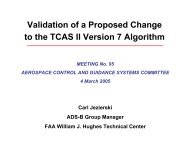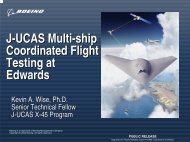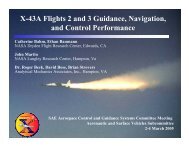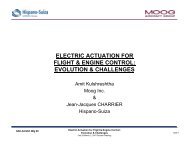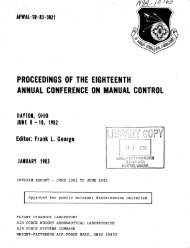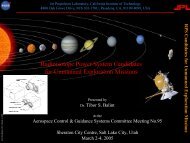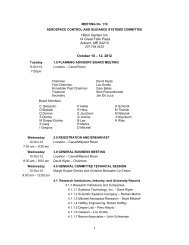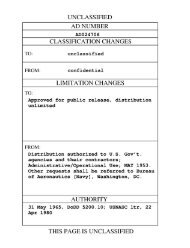Report of the Second Piloted Aircraft Flight Control System - Acgsc.org
Report of the Second Piloted Aircraft Flight Control System - Acgsc.org
Report of the Second Piloted Aircraft Flight Control System - Acgsc.org
You also want an ePaper? Increase the reach of your titles
YUMPU automatically turns print PDFs into web optimized ePapers that Google loves.
~dditional means were tried in laboratory tests to improve performance.<br />
Damping in <strong>the</strong> feedback loop was tried, although better results<br />
were obtained, <strong>the</strong> installation complications did not warrant<br />
its use. The use <strong>of</strong> a double om rlng piston also helped to reduce<br />
phase lag by reducing backlash <strong>of</strong> <strong>the</strong> system. Although <strong>the</strong> improvement<br />
did not reach <strong>the</strong> magnitude desired, <strong>the</strong> double ROW ring piston<br />
was installed since bacldash uill deterlorate aw system.<br />
The main problem, that <strong>of</strong> low spring rates <strong>of</strong> <strong>the</strong> system, still<br />
remained, and prevented necessary increase in system gain to obtain<br />
better response. This problem can be illustrated by referring to<br />
a basic type power operated control system using a direct feedback<br />
linkage as shown schematically in figure 4. It can be seen that<br />
external disturbance to <strong>the</strong> control surface or mass results in<br />
deflection <strong>of</strong> <strong>the</strong> reaction structure. If <strong>the</strong> input system is held<br />
fixed while <strong>the</strong> reaction structure is deflected, <strong>the</strong> followup linkage<br />
opens <strong>the</strong> control valve in a direction to oppose this disturbance.<br />
~f <strong>the</strong> system has high gain, <strong>the</strong> control 'valve may admit<br />
enough energy to cruse <strong>the</strong> system to over correct <strong>the</strong> surface position.<br />
Due to <strong>the</strong> inertia <strong>of</strong> <strong>the</strong> surface <strong>the</strong> over correction causes<br />
a deflection <strong>of</strong> <strong>the</strong> structure In <strong>the</strong> opposite direction which in<br />
turn again opens <strong>the</strong> valve and again excess energy is admlttecl ad<br />
<strong>the</strong> cycle is repeated. If <strong>the</strong> energy admltted per cycle is equal<br />
to or greater than that extracted by aerodynamic damping and friction<br />
<strong>of</strong> <strong>the</strong> system, <strong>the</strong> surface will continue to oscillate. The<br />
amount <strong>of</strong> energy that is added to <strong>the</strong> gystem is prinudly detelc<br />
mined by <strong>the</strong> flow characteristics <strong>of</strong> <strong>the</strong> mstering vahe and mry be<br />
kept small if <strong>the</strong> flow per unit deflection is emall. Stability<br />
mey, <strong>the</strong>refore, be achieved by ube <strong>of</strong> a law gain valve. This<br />
improvement in stabil%ty <strong>of</strong> <strong>the</strong> system is obtained at <strong>the</strong> expense<br />
<strong>of</strong> speed <strong>of</strong> response.<br />
As very little can be done about <strong>the</strong> hydraulic spring rate and as<br />
<strong>the</strong> structure stiffness can be increased only to a limited degree,<br />
it was evident that some o<strong>the</strong>r means should be coxwidered to compensate<br />
for all <strong>of</strong> <strong>the</strong> system spring rates.<br />
ADDITION OF STRUCTURAL COMPE2SATION TO THE BASIC TYPE SISTBl<br />
High performance <strong>of</strong> a servomechanism cannot be obtained if lack <strong>of</strong><br />
stability lindts <strong>the</strong> allowable gain. Therefore, <strong>the</strong> stability <strong>of</strong><br />
<strong>the</strong> system is <strong>the</strong> gwerning factor. Improvement can be obtained by<br />
increasing ei<strong>the</strong>r spring rate or damping or by reducing <strong>the</strong> mass.<br />
For this system <strong>the</strong> mass could not be reduced and adding damping to<br />
<strong>the</strong> output was not considered practical or desirable, leaving <strong>the</strong><br />
reaction spring rate as <strong>the</strong> factor to be considered in order to<br />
Improve stability.



